Beirut, Lebanon
| Credit: DigitalGlobe. Copyright (c) DigitalGlobe. ALL RIGHTS RESERVED. Online and news media distribution or publishing requires permission from DigitalGlobe. | ||
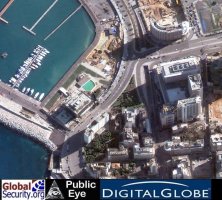
Overview of Beirut waterfront on 21 December 2003. |
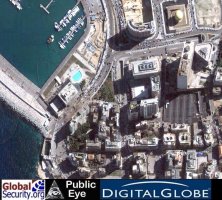
Overview of Beirut waterfront on 15 February 2005. |
|
| These images show the Beirut downtown waterfront area before and after the explosion. Damage to the St. George hotel, located between the explosion and the marina is visible. | ||
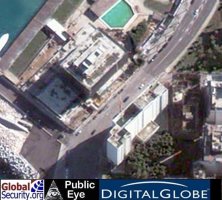
Detail of St. George Hotel. Image date 21 December 2003. |
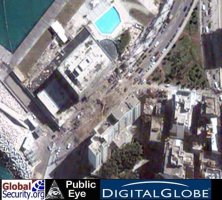
Detail of St. George Hotel and explosion site. Image date 15 February 2005. |
|
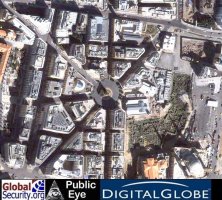
Overview of Parliament building where Mr. Hariri had been meeting that afternoon. Image date 15 February 2005. |
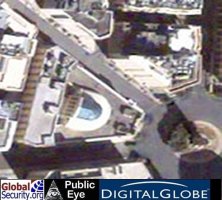
Detail of Parliament building. Image date 15 February 2005. |
|
Rafik al-Hariri Assassination
On 14 February, 2005 Lebanon's Former Prime Minister Rafik al-Hariri was killed when a bomb exploded on his motorcade. Seven bodyguards were also killed in the attack and at least 120 people were wounded, including former Economy Minister Basil Fuleihan. The explosion occured in Beirut's waterfront area known as Corniche. It left a large crater in the road and caused severe damage to nearby buildings, including the St. George Hotel. Hariri was taken to Beirut's American University Hospital where he was pronounced dead.
At the time Hariri was travelling in a five Mercedes armored motorcade. Reportedly his vehicle was equipped with powerful jamming equipment designed to defeat roadside explosives. The blast, reportedly caused by 70 pounds of explosives, destroyed windows more than a kilometer away from the attack and could be heard beyond the city limits. Earlier that day Hariri had been consulting with the Lebanonese Parliament about upcoming May elections.
Hariri was a self-made billionare who helped rebuild Lebanon after a 15 year civil war ended in 1990. He payed particular attention to rebuilding the downtown waterfront area and uniting the country's Muslim and Christian communities. Hariri resigned as Prime Minister last year in a disagreement with Syria and the Lebanese parliament. Syria, which maintains 15,000 soldiers in Lebanon forced the legislature to amend the constitution to allow pro-Syrian President Emile Lahoud to serve a third term.
Responsibility for the blast remains unclear. Given Hariri's disagreements with Syria, many in Lebanon suspect Damascus of being involved. Syria denies responsibility and called the bombing a "horrendous atrocity" and expressed "deep sorrow." Shortly after the attack a group known as the Organization of Nasrat and Jihad in Bilad Sham claimed responsibility for the attack in a videotape aired on Al Jazeera. They called Hariri "an agent of the Saudi regime" and said his murder was in retaliation for fighters killed by Saudi authorities. Lebanese security forces have stated that a suicide bomber was responsible for the attack. They have identified a Palestinian living in Beirut named Ahmed Abu Adas as being responsible and say he was linked a group with ties to Al Qaeda.
On February 16 Hariri was buried in the Amin mosque, a building still under construction. At least 200,000 mourners filled the streets and expressed a variety of emotions, including anger at Syria as well as a desire for unity between the Muslim and Christian communities.
|
NEWSLETTER
|
| Join the GlobalSecurity.org mailing list |
|
|
|


